Managing innovation starts with collecting and evaluating ideas to find the best ones.
However, for higher-risk, higher-uncertainty ideas, such as breakthrough ideas, there will still be a lot of unknowns around them because they require substantial resources, and the company hasn’t done anything like that before. It wouldn’t be wise to dedicate resources to full-scale implementation without reducing risk and uncertainty first. This is where innovation projects come into play.
Managing innovation projects entails conducting experiments to validate key aspects of an idea, such as demand, profitability, and feasibility. The goal is to reduce risk and uncertainty and build enough confidence to warrant proceeding with implementation.
As innovation managers who have managed countless innovation projects inside dozens of companies, we've seen that successful innovation management hinges on three factors:
People: You need employees with the right skill sets to run experiments and test ideas. For each project, you typically need an engineer, a designer, and a marketer. Stakeholders will use the outcomes of these experiments to determine whether to implement an idea.
Process: Successful innovation projects typically go through a few stages. Teams map assumptions, run experiments to test them, track and report on their outcomes, and repeat this process until all assumptions are validated. Top management and other decision-makers then review experimentation results and assess whether full implementation funding is justified.
Platform: Employees commonly struggle with validating ideas because the company doesn’t provide them with the workflows and guidance needed to do so. Innovation management is messy, nonlinear, and involves a lot of learning and pivoting. It requires knowledge of assumption mapping and experimentation, and most employees don’t know how to manage this innovation process. Companies with the best systems use dedicated software to guide teams and manage innovations at scale.
In this article, we'll discuss how we manage innovation projects and how the right combination of people, platforms, and processes can help companies drive innovation and turn new ideas into measurable ROI.
We also share key learnings from our experience — what best practices have worked well for us, the common mistakes we've seen companies make, and how to avoid them.
Book a 25-minute demo to learn more about how InnovationCast helps teams manage innovation projects at scale.
1. People: Gather the Right People Needed to Work on the Innovation Project
The first step in managing an innovation project is to assemble a small team responsible for the idea. This team is known as the innovation or validation team, and they will design and run experiments to reduce risk and uncertainty.
While the exact competencies you include in your team will vary depending on the idea, we’ve found that having an engineer, designer, and marketer is common.
An engineer who can build functional prototypes: Their role isn’t to create a polished application from day one but to build just enough for testing and iteration. They help bring the idea to life in a way that users can interact with, which is needed for real-world feedback.
A designer responsible for UX/UI, user flows, and overall usability: They ensure that what’s being built is functional and user-centered. At this stage, it's less about pixel-perfect design and more about rapidly prototyping experiences that reflect how people will use the product.
A marketer who focuses on testing messaging, running ads, and gathering insights from early users: Their job is to ensure the team learns what resonates and where demand exists.
How InnovationCast Helps Companies Engage the Right People
While each employee may run their piece of the project using their own tools — for example, the developer might use React, the designer may use Figma, and the marketer may use HubSpot — you still need a centralized location where the innovation project can be tracked from idea to implementation for a few reasons:
Stakeholders can stay up to date on progress: This helps secure future funding because stakeholders know progress is made, risk is reduced, and teams aren’t spending resources with nothing to show for it. Without a centralized platform aggregating progress, stakeholders sometimes think there’s little benefit to funding innovation projects.
It helps keep the innovation team connected: Everyone knows their teammates' progress and when their input is needed, preventing innovative ideas from stalling.
The original ideators can keep track of what happens to their ideas: This is important for boosting morale and encouraging employees to continue submitting ideas so that innovation projects continue. When employees cannot see their ideas’ progress, they default to thinking they’re collecting dust, and they stop sharing ideas.
These are some of the reasons why we built InnovationCast, our own innovation management software. With InnovationCast:
Stakeholders can see all the innovation projects running across the entire company within a single dashboard. This insight helps them understand the financial value of innovation and enables innovation managers to secure continued funding.

Members of the validation team can easily track their colleagues' progress and experiment outcomes, communicate about learnings and knowledge gained, store everything for others to see, and know when their expertise is needed. This keeps innovation projects organized and moving forward.
Employees can view the ideas they submitted and their progress. As teams evaluate and validate innovative ideas, employees can view the evaluation criteria, assumptions, experiments, and results. Keeping employees in the loop shows them that their ideas aren’t going to waste, allowing companies to build thriving cultures of innovation.
Read more: 5 Best Ideation Platforms (Review Guide)
2. Platform: Set Up the Workflows to Guide Validation Teams on How to Test Different Types of Creative Ideas
In our experience, providing validation teams with the workflows and guidance on validating ideas is necessary for successfully managing innovation.
Most employees lack innovation and portfolio management experience, and therefore don’t know how to reduce risk and uncertainty systematically through experimentation. They are engineers, designers, and marketers, not innovation managers.
Managing innovation isn’t like traditional project management, where everyone knows what to build and how to build it, and all the tasks and deadlines are neatly lined out. Innovation management is hypothesis-driven work; it’s iterative and nonlinear. It’s filled with constant learning and ambiguity, pivoting based on new knowledge, and iterating on previous concepts.
Without guidance on how to manage innovation, validation teams test ideas using random trial and error, spinning their wheels and leading to wasted resources and promising ideas being dismissed too early.
Given this, we used our decade of experience as innovation managers to design InnovationCast with comprehensive workflows that offer step-by-step support for testing different kinds of ideas.
InnovationCast workflows provide clarity on roles and actions while making the guidance scalable across hundreds of innovation projects, so the innovation department doesn't have to oversee every project directly.
How InnovationCast Workflows Facilitate Effective Experimentation and Problem-solving
InnovationCast comes with distinct workflows to manage different types of innovation projects.
We have separate workflows for process efficiency ideas, business model ideas, product improvement ideas, new product ideas, and more. This is important because validation steps vary massively depending on the idea's nuances. Generally speaking, however, our workflows follow a couple of key stages.
Assumption mapping: Help teams understand factors that must be true for the idea to be successful and potential risks that can endanger the project. (More on this below.)
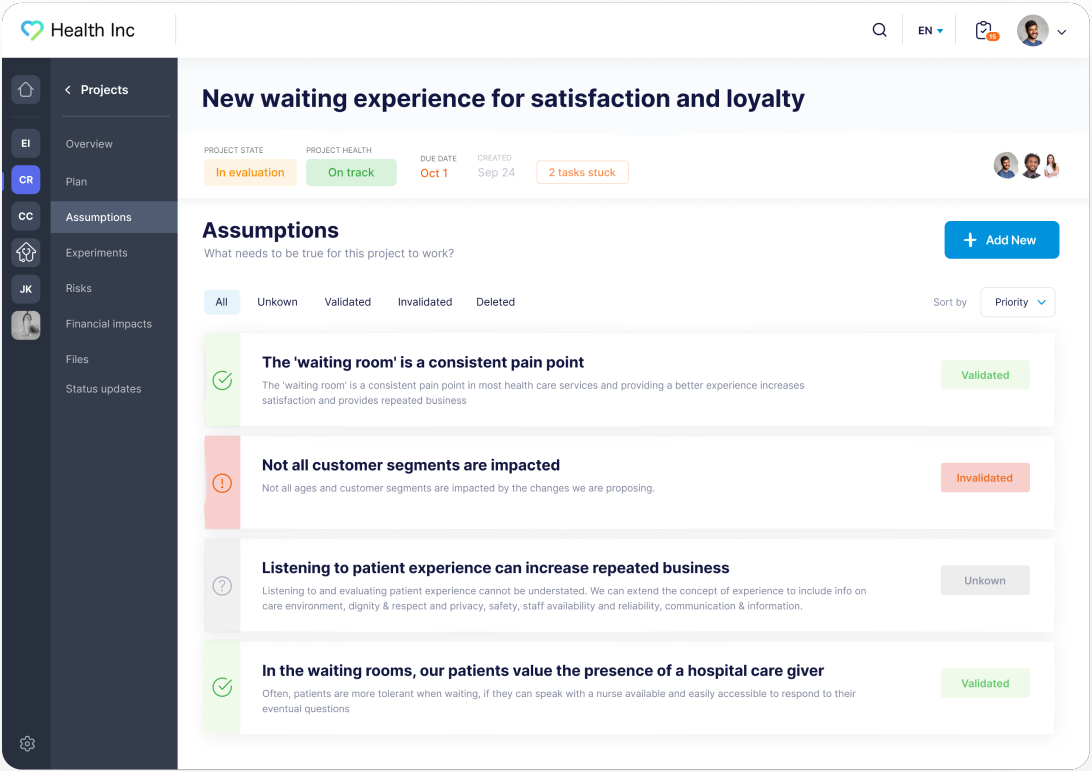
Experimentation: Guide teams in designing and running effective experiments to test assumptions and reveal weak points in the concept early on.
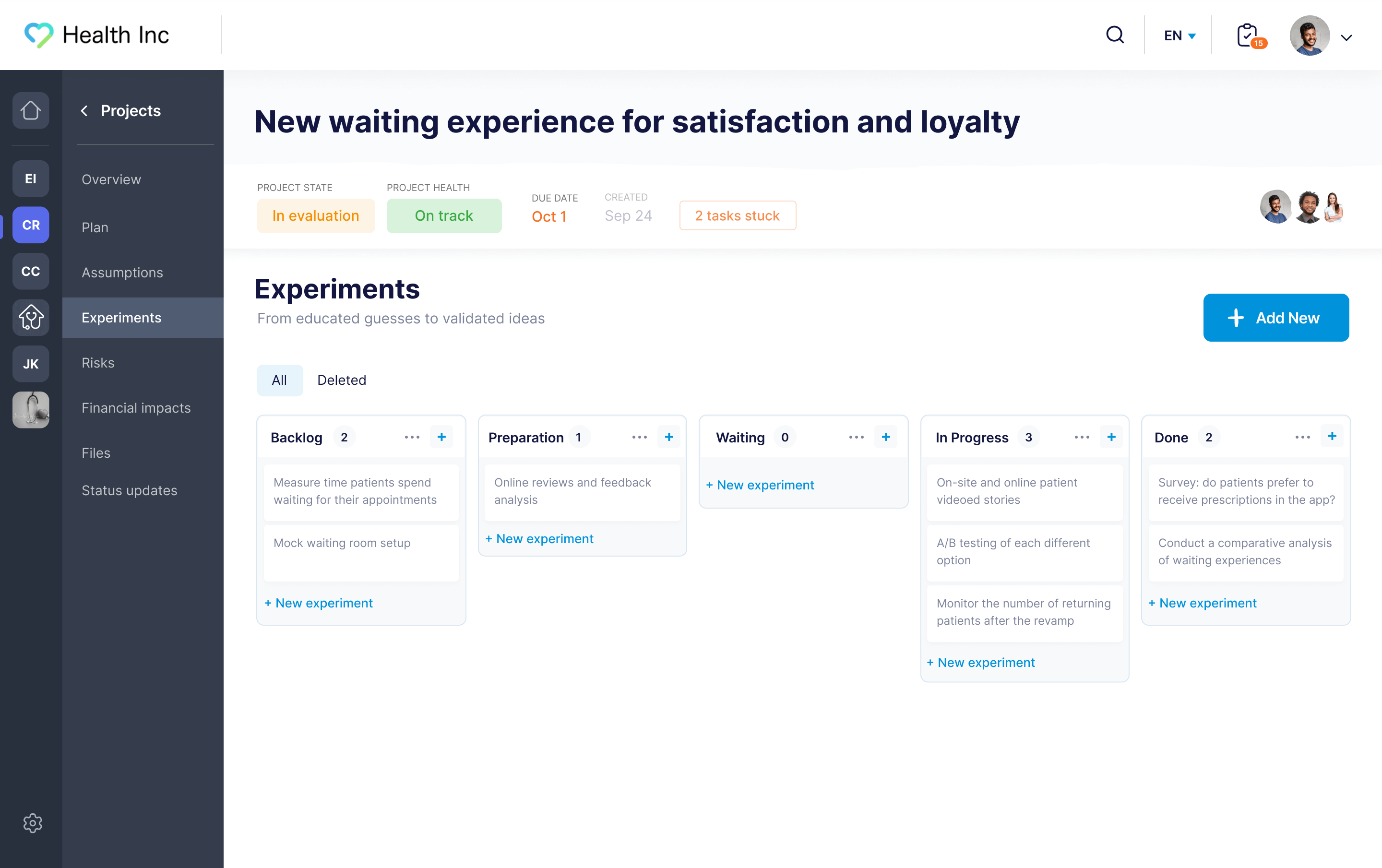
Evidence gathering: Assist teams in determining what metrics to track to support their ideas and when and how to pivot if their assumptions are invalid.
Funding strategies: Provide guidance to top management on how to fund different types of projects and minimize wasted resources.
For example, here’s a workflow for continuous improvement ideas:

Here’s another example, this time for new product ideas:
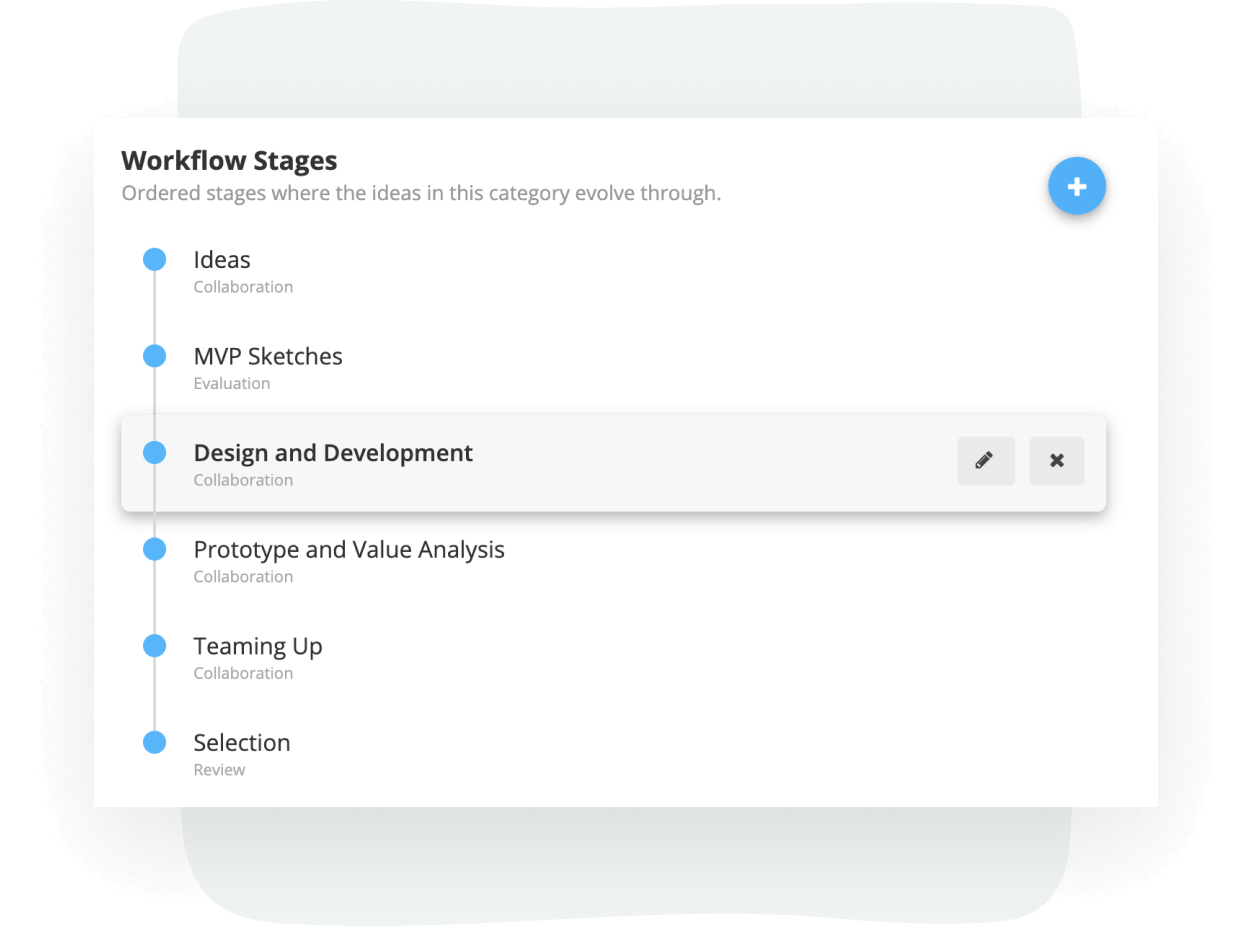
As innovation managers, we've developed these workflows through a combination of experience and key learnings — figuring out what approaches deliver value and what doesn’t. We’ve also taken advice from ISO 56000 and methodologies like Evidence-Based Innovation, Customer Development, Lean Startup, Design Thinking, and Discovery-Driven Growth.
We’ll collaborate with you during onboarding to learn about your innovation strategy and goals so we can design agile workflows tailored to them. However, you can easily change them by adding, deleting, or rearranging workflow stages.
To get started, assemble a validation team by inviting them to the InnovationCast platform so they can see which ideas they are responsible for validating.
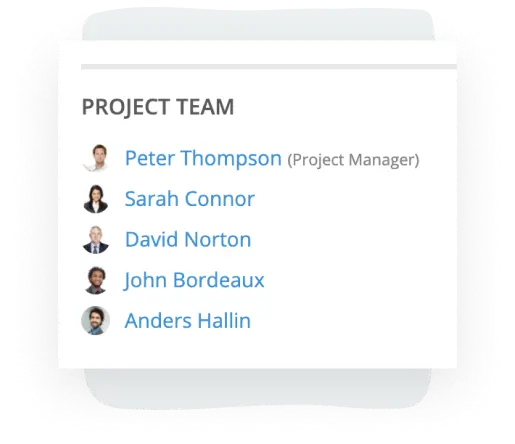
As team members run experiments and validate new ideas, all the knowledge gained is stored in the InnovationCast reporting dashboard that stakeholders and other decision-makers can access.
3. Process: Reduce Risk and Uncertainty in the Idea through Systematic Experimentation
There are five steps to effectively managing innovation projects:
Map assumptions
Run experiments to test assumptions
Track and report on the outcomes of those experiments
Test the next assumption
Implement the idea
Map Assumptions
When tasked with validating an idea, the first thing validation teams and innovators should do is map out assumptions, which are beliefs or hypotheses that must hold true for an idea to work. For example:
Users experience the problem we’re addressing
Users are actively seeking a solution to this problem
We have the technical capability to build the solution
The solution can be delivered within our resource limits
Users are willing to pay or engage with the solution
When mapping out assumptions, we encourage teams to clearly articulate what their innovation is meant to achieve and the problem it is intended to solve. This problem statement acts as the basis for mapping assumptions.
For example, when testing a mobile app that helps freelancers track their time and automatically generate invoices, the problem statement may be that freelancers often lose billable hours and struggle to create accurate, professional invoices, leading to lost income.
With that problem statement in hand, break it down further by asking: what must be true for the innovation to address those problems? We recommend grouping assumptions into five categories:
Desirability: Do people want it? Freelancers frequently experience this problem and are actively looking for a better tool.
Feasibility: Can we build it? We can access the necessary time-tracking data via APIs or native integrations and build the app at a reasonable cost.
Viability: Is it worth it? Freelancers are willing to pay for a tool that simplifies invoicing.
Usability: Can people use it easily? Freelancers would trust an automated solution to track time accurately.
Scalability: Can we grow the solution over the medium and long term? The system can support thousands of users without performance issues.
Next, teams should assess the level of risk and uncertainty associated with each assumption, prioritize them from highest to lowest, and test those with the greatest risk and uncertainty first. This way, they can quickly uncover problems that compromise the project.
The highest risk and uncertainty assumptions usually relate to user acceptance and technical feasibility. If nobody wants the innovation and the company cannot build it, the project should be terminated.
Final piece of advice: We recommend working with top management to come to conclusions on the most critical assumptions. This step is essential for securing implementation funding later down the road. Since top management has approved the assumptions, the validation team is confident that implementation funding will be granted if all are successfully validated.
Too often, we see validation teams mapping out assumptions without input from top management. Once they’ve validated the most important assumptions, top management isn’t willing to fund the implementation because they still believe it’s too risky.
How InnovationCast Helps Teams Map Assumptions
When assigned an innovation project, validation teams can find the idea they are responsible for on their innovation dashboard alongside tools that’ll help them map out assumptions, such as assumption templates, risk mapping boards, and agile validation workflows.
InnovationCast also includes examples and best practices to help users learn how other validation teams have validated similar ideas.
Once they’ve mapped out assumptions, InnovationCast prompts validation teams to consider certain factors to determine risk and uncertainty.
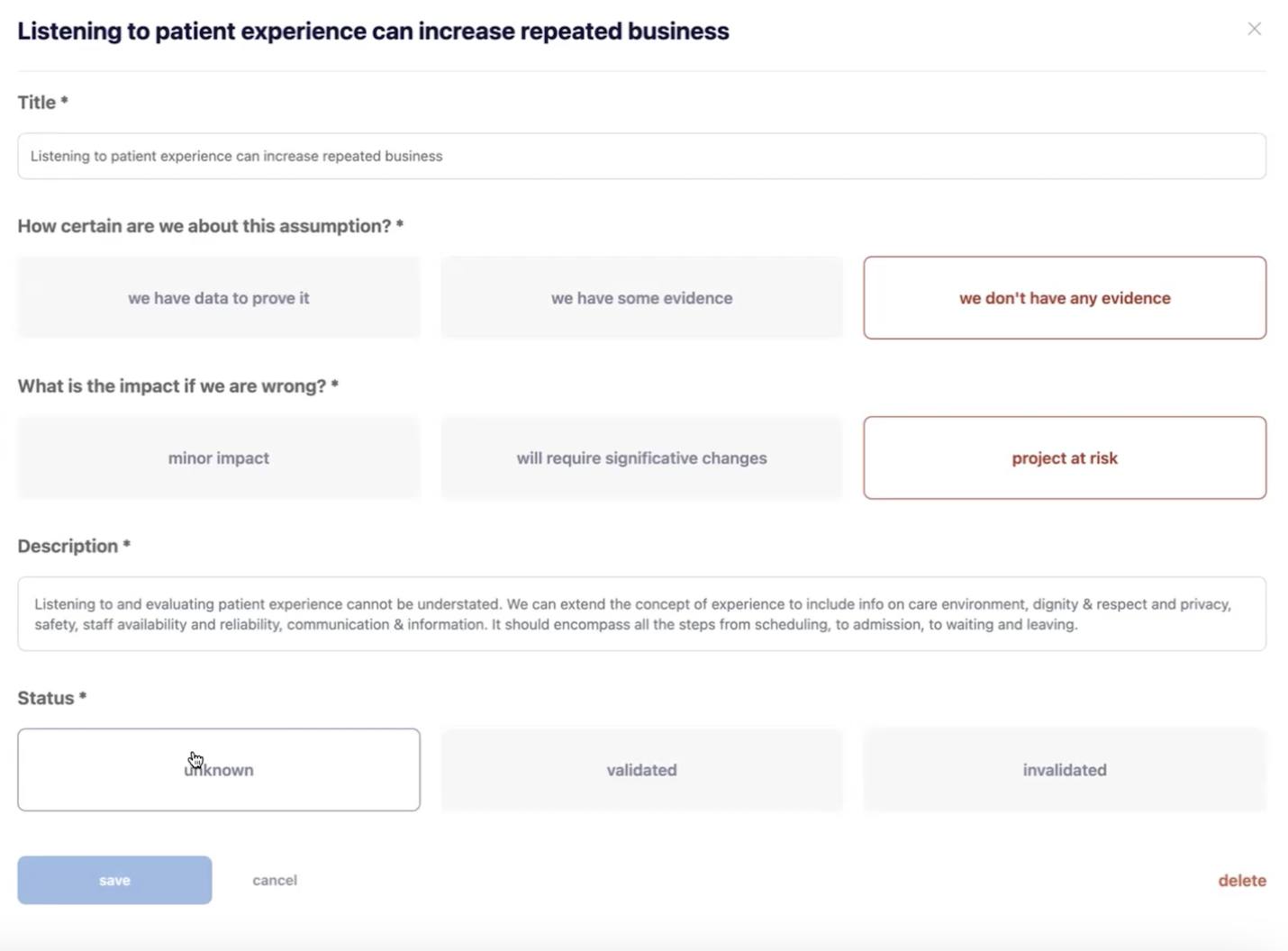
InnovationCast automatically sorts these assumptions from highest to lowest risk and uncertainty.
Validation teams can also tag or label assumptions, track their status (e.g., untested, validated, or invalidated), assign deadlines, and link them to experiments.
This guidance ensures teams have the clarity and support to map assumptions effectively so innovation projects gain momentum instead of stalling or being left on the back burner due to a lack of direction.
Run Experiments to Test Each Assumption
Once teams are clear on the assumptions that must be true for their idea to work, they should run experiments to test each one, starting from the one with the most risk and uncertainty. These experiments are very low-cost and are meant to help teams learn what’s true, what’s not, and what needs to change about an idea.
Here are a few common experiments we see teams use to validate their assumptions:
Create a simple landing page that describes your idea. Drive traffic to it via ads, email, or social media, and track the number of people who join the waiting list.
Add a button to your app that introduces the new feature you’d like to test, and that leads to a “Coming Soon” page. Then, track how many people click on this button.
Deliver the service manually to a few users without any software or automation. Observe how they respond, what they value, and where they struggle. This helps validate the concept before investing in product development.
Build a working front-end interface, but fake the backend functionality by manually completing tasks behind the scenes. Track how users interact with the experience and gather feedback on usability and expectations.
Each experiment acts as a stage gate, which is a checkpoint during the innovation project where everyone reviews the knowledge gained so far, considers whether assumptions are valid or invalid, and decides whether or not to continue.
The most common mistake we see companies make here is providing the funds for all the stage gates before a single experiment has been run. Essentially, funding the entire innovation project from the get-go.
This has a few problems:
Companies limit the number of innovation projects they can fund: When teams are given full validation funding, they often default to designing higher-cost experiments instead of prioritizing lean, efficient testing methods. As a result, companies assign more resources to each project and limit the number of ideas they can test at once.
Companies struggle to pivot during stage gates: Funding the entire innovation project makes it difficult for the company to reallocate resources during stage gates based on knowledge gained. Impractical ideas may receive a lot of funding, while promising ideas may not receive the necessary support.
Fund Innovation Projects Using a Metered Funding Approach
Our advice for designing cheap and effective experiments (beyond offering teams guidance on how to validate ideas) is to use Metered Funding.
Metered Funding is an approach to allocating resources gradually, releasing funding in small increments based on evidence and progress rather than committing to a large budget upfront.
Top management assigns validation or project teams with just enough resources to validate the first few assumptions. If teams can validate those assumptions, they receive more funding to validate the next few. If they cannot, funding stops, and the idea is terminated.
For example, instead of giving the validation team $30K to validate user acceptance, feasibility, impact, profitability, and scalability, top management may only provide $5K to validate user acceptance. The validation team unlocks the next round of funding once they've proven there's demand for the idea.
There are two main benefits to Metered Funding:
Companies can fund a higher volume of projects: Because top management only provides enough resources to validate the first couple of assumptions, teams are required to run the most cost-effective experiments possible. Consequently, companies can test more ideas and fund more validation projects.
Companies can easily pivot at each stage gate based on learnings: They remain flexible because they can use the knowledge gained by validation teams to understand which ideas are most promising and quickly reallocate resources away from impractical ideas. Support naturally flows toward the ideas that demonstrate the most value.
How InnovationCast Helps Teams Design and Run Experiments
Once validation teams have mapped out assumptions, InnovationCast guides them through the process of designing and running experiments to test those assumptions.
InnovationCast guidance includes templates on what type of experiments to run depending on the assumption and the associated level of risk and uncertainty. This helps teams plan what they want to learn, how to test it, and what success looks like.
Teams can connect experiments to specific assumptions, track progress, and record all their learnings in one place.
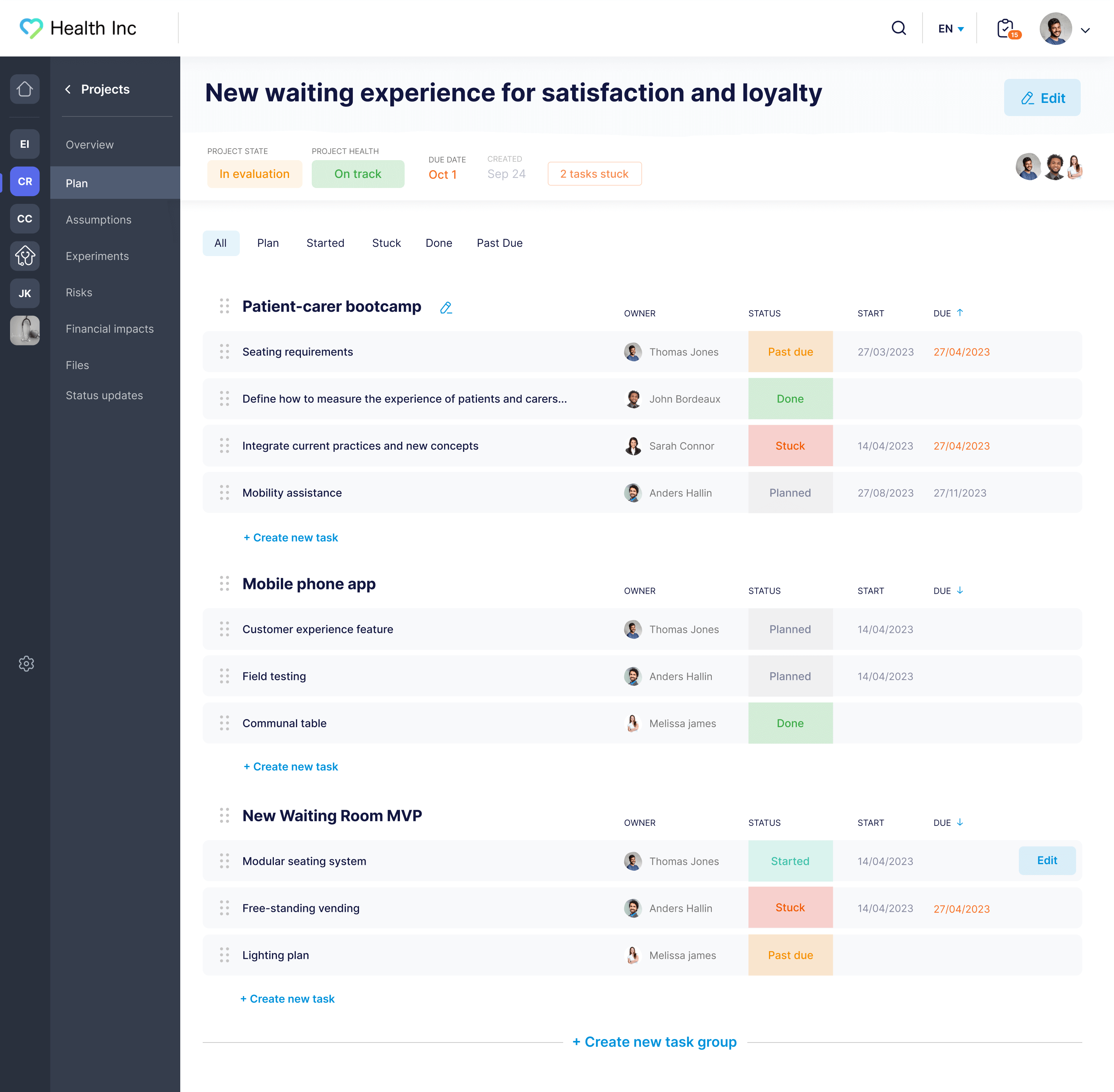
In addition, InnovationCast acts as a consulting partner by always being available on call to help offer advice tailored to your specific situation, answer any questions you may have, and even troubleshoot projects.
Track and Report on the Outcomes of Those Experiments
Once teams have run experiments to test assumptions and gather learnings, it’s important to centralize the data in a platform where stakeholders and decision-makers can view it. The data gathered from experiments is only helpful if relevant stakeholders can access it, not if it’s in someone's notes app.
Centralized knowledge gathering keeps leadership aligned and confident in the ROI of innovation projects. Stakeholders want to know that innovation efforts are being run responsibly. Transparent reporting builds trust and shows that the team is learning systematically, not just spinning in circles.
Doing this is essential to continuing to secure a budget for future innovation projects.
After each assumption, validation teams have a decision to make:
Full steam ahead: If the assumption is validated with strong evidence, teams can confidently proceed to the next assumption, knowing that the risk tied to it is now reduced.
Pivot: If the assumption was invalid but there are signs that the idea is still worth exploring — perhaps customers aren’t willing to buy the product because it’s too expensive, but may be willing to rent it — teams should adjust the idea based on what they’ve learned.
Terminate: If the assumption is invalid and the validation team cannot pivot around it, they should stop working on the idea. Top management should reallocate resources to more promising ideas.
How InnovationCast’s Reporting Dashboard Helps Teams Track and Centralize Progress
As teams run experiments, their learnings are automatically imported into the InnovationCast reporting dashboard for stakeholders and key decision makers to see. They can track the following metrics and use them to fuel their decision-making:
Revenue and profit generated
Cost savings
Experiment success rate
Time-to-insight
Adoption rate of validated ideas
Customer satisfaction impact
ROI of innovation initiatives
Other teams and departments can see company-wide experiments and track those projects, preventing repeat work. This enables them to build upon the knowledge gained by others, eliminating the need to start from scratch.
Test the Next Assumption
The innovation process described above occurs for each assumption and experiment. So once you’ve validated an assumption and reported on the outcome to top management, start from the beginning and test the next assumption until everything has been validated.
Once teams have run experiments and validated all their assumptions about an idea, risk and uncertainty are reduced, and it makes sense for the company to spend resources on the full implementation.
Use InnovationCast to Provide Teams with Guidance on Managing Innovation Projects
If you’d like to see how InnovationCast’s agile workflows can structure the idea validation process within your organization, schedule a quick call with our team here.
Related reads:

